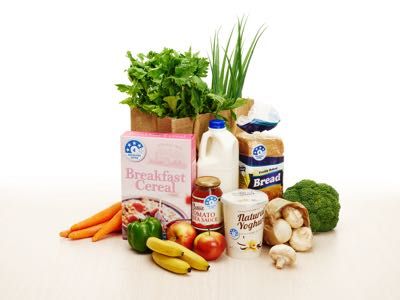Understanding food labels
With our supermarket aisles overflowing with choice and the persuasive influence of clever marketing and ‘buzz’ nutrition words, choosing the healthiest option is not always obvious.
We’ve put together an easy guide to help you cut through the claims and decide for yourself if a food is a healthy choice.

It’s all about the label
Most packaged foods have a nutrition panel and an ingredients list. Here are some things to look out for.
Click each highlighted section to find out more.
| Nutrition information | ||
|---|---|---|
| Serving size: 30 g (2/3 cup) | Servings per package: 16 | |
| Per Serving | Per 100 g | |
| Energy | 432 kJ | 1441 kJ |
| Protein | 2.8 g | 9.3 g |
| Fat | ||
| – Total | 0.4 g | 1.2 g |
| – Saturated | 0.1 g | 0.3 g |
| Carbohydrate | ||
| – Total | 18.9 g | 62.9 g |
| – Sugar | 3.5 g | 11.8 g |
| Fibre | 6.4 g | 21.2 g |
| Sodium | 154 mg | 513 mg |
| Ingredients: Cereals (76%) ( Wheat , oatbran, barley), psyllium husk (11%), sugar, rice malt extract, honey, salt, vitamins (niacin, thiamine, folate) | ||
Sneaky names for sugar, fat and salt
Sugar, fat and salt often have different names on the ingredients list. Watch out for these.
Sugar
Agave nectarBrown/cane/raw sugar
Corn syrup
Dextrose
Fructose
Fruit juice/puree concentrate
Glucose
Golden syrup
Honey
Invert sugar
Malt
Maple syrup
Molasses
Rice syrup
Sucrose
Salt
Celery saltFlavour enhancer 621 (MSG)
Pink salt
Meat/vegetable/yeast extract
Rock salt
Sea salt
Sodium
Soy sauce
Stock
Table salt
Fat
ButterCocoa butter
Coconut oil
Copha
Cream
Ghee
Hydrogenated oil
Lard
Margarine
Oils (of any kind)
Shortening
Suet
Tallow
How to tell if a packaged food or drink is a healthy option
For a quick guide to the healthiness of packaged foods and drinks, use our simple guide. These numbers are not the only important thing, but they’re a good place to start.
Many items will have different nutrients fall into different colour categories. As a rough guide, aim to have at least two nutrients in the green column and no nutrients in the red column.
Choose foods and drinks that are lower in saturated fat, sugar and sodium.
| COMPARE the per 100 g/mL column | Best choice |
OK sometimes |
Too high |
|---|---|---|---|
| Satured fat | Under 1.5 g | 1.5 - 3 g | Over 5 g |
| Sugar (food) | Under 5 g | 5 - 15 g | Over 15 g |
| Sugar (drinks)* | Under 2.5 g | 2.5 - 5 g | Over 5 g |
| Sodium | Under 120 mg | 120 - 400 mg | Over 400 mg |
*Drinks without added sugar or sweetener like water and plain milk are best.
More fibre is good for health.
| COMPARE the per serving column | Excellent |
Good |
Low |
|---|---|---|---|
| Dietary fibre | Over 7 g | 4 - 7 g | Under 4 g |
Free label reading wallet card
Click each highlighted nutrient to find out if the food is a healthy option.
| Nutrition information | ||
|---|---|---|
| Serving size: 30 g (2/3 cup) | Servings per package: 16 | |
| Per Serving | Per 100 g | |
| Energy | 432 kJ | 1441 kJ |
| Protein | 2.8 g | 9.3 g |
| Fat | ||
| – Total | 0.4g | 1.2g |
| – Saturated | 0.1g | 0.3g |
| Carbohydrate | ||
| – Total | 18.9g | 62.9g |
| – Sugar | 3.5g | 11.8g |
| Dietary fibre | 6.4g | 21.2g |
| Sodium | 154mg | 513mg |
| Ingredients: Cereals (76%) ( Wheat , oatbran, barley), psyllium husk (11%), sugar, rice malt extract, honey, salt, vitamins (niacin, thiamine, folate) | ||
Whole foods, foods without a label and foods with only a few ingredients are usually cheaper and better for our health. This includes fruits and vegetables, nuts and seeds, legumes, eggs, fish, red meat, chicken, dairy foods and wholegrains.
Health star rating

The Health Star Rating looks at the overall healthiness of a product and gives it a score out of 5 stars. More stars are given to more nutritious foods.
When is it useful?
The Health Star Rating is made to compare similar foods. For example, comparing different flavours of muesli bar or different kinds of yoghurt. Use the stars to help choose which yoghurt to buy, rather than to decide whether to buy a yoghurt or a muesli bar.
When to be careful
The star ratings are only on packet foods. So many foods that deserve 5 stars (like fresh fruit and vegies) don’t show them.
Food companies sometimes only put them on their healthier items or flavours. Some food companies don’t use them at all, but this doesn’t necessarily mean they’re not a healthy option.
The stars are not made to compare foods in different categories. For example, a 4-star breakfast cereal might not be a better option than a 3.5-star yoghurt. Use the stars to find healthier options in each category.